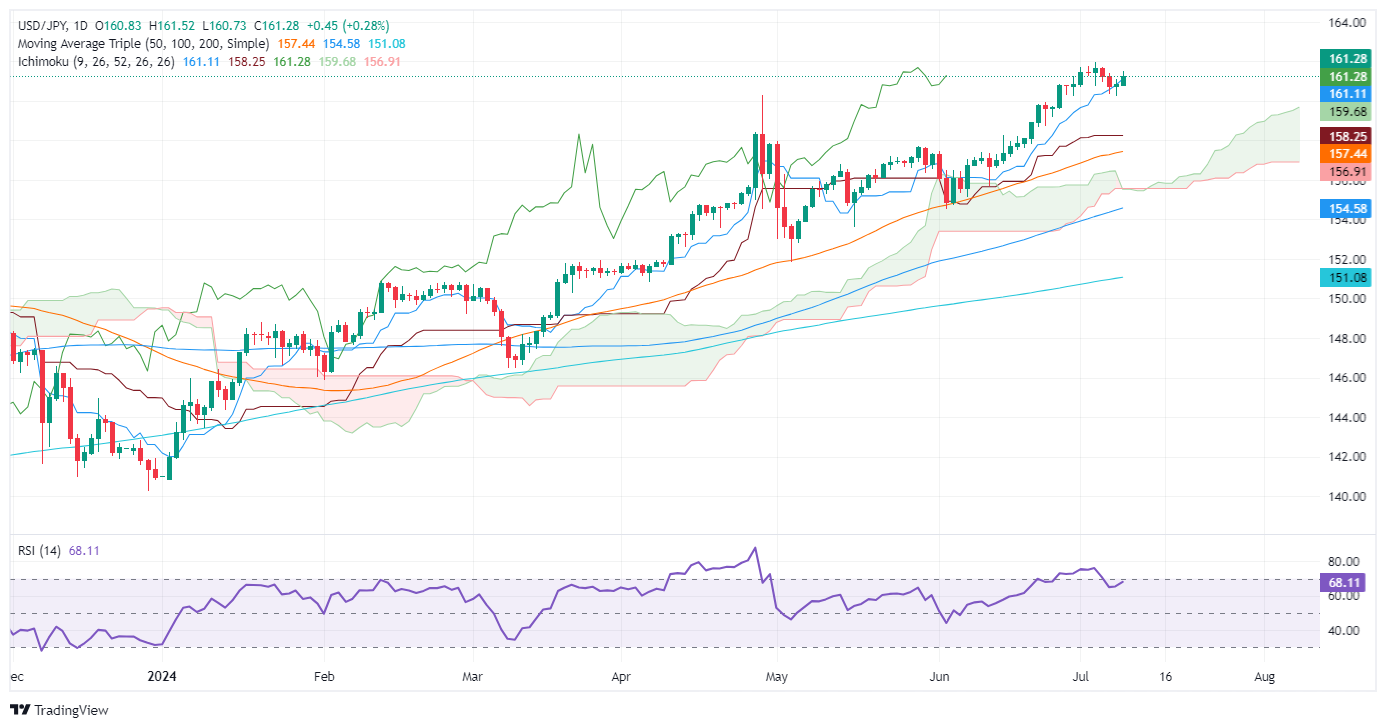- Analytics
- News and Tools
- Market News
- USD/JPY Price Analysis: Rises past 161.00 as Powell stays cautious
USD/JPY Price Analysis: Rises past 161.00 as Powell stays cautious
- USD/JPY edges higher eyeing YTD high of 161.95 with strong RSI support.
- Formation of 'morning star' pattern suggests potential for further gains above 162.00.
- Key support at July 8 low of 160.26, with significant resistance at November 1986 high of 164.87.
The USD/JPY advanced for the second straight day and climbed above the 161.00 figure on Tuesday as Fed Chair Jerome Powell remained cautious on rate cuts despite acknowledging that the US central bank's dual mandate risks are more balanced. The pair trades at 161.29 and gains 0.28%.
USD/JPY Price Analysis: Technical outlook
The USD/JPY pair's uptrend is robust, with buyers poised to surpass the year-to-date (YTD) high of 161.95. The bullish Relative Strength Index (RSI) indicates the momentum is in their favor. Despite hovering around overbought conditions, the successive series of higher highs and higher lows justifies another leg up.
The major snapped back-to-back days of losses as a doji emerged on Monday, and today’s price action completed a ‘morning star’ chart pattern, hinting that a higher price loom.
If USD/JPY clears the psychological 161.50, the next resistance would be the YTD high ahead of 162.00. Additional gains lie overhead at the November 1986 high of 164.87.
On the other hand, if sellers step in and drag the USD/JPY exchange rate below the July 8 cycle low of 160.26, that will clear the path to challenging the 160.00 figure.
USD/JPY Price Action – Daily Chart
Japanese Yen FAQs
The Japanese Yen (JPY) is one of the world’s most traded currencies. Its value is broadly determined by the performance of the Japanese economy, but more specifically by the Bank of Japan’s policy, the differential between Japanese and US bond yields, or risk sentiment among traders, among other factors.
One of the Bank of Japan’s mandates is currency control, so its moves are key for the Yen. The BoJ has directly intervened in currency markets sometimes, generally to lower the value of the Yen, although it refrains from doing it often due to political concerns of its main trading partners. The current BoJ ultra-loose monetary policy, based on massive stimulus to the economy, has caused the Yen to depreciate against its main currency peers. This process has exacerbated more recently due to an increasing policy divergence between the Bank of Japan and other main central banks, which have opted to increase interest rates sharply to fight decades-high levels of inflation.
The BoJ’s stance of sticking to ultra-loose monetary policy has led to a widening policy divergence with other central banks, particularly with the US Federal Reserve. This supports a widening of the differential between the 10-year US and Japanese bonds, which favors the US Dollar against the Japanese Yen.
The Japanese Yen is often seen as a safe-haven investment. This means that in times of market stress, investors are more likely to put their money in the Japanese currency due to its supposed reliability and stability. Turbulent times are likely to strengthen the Yen’s value against other currencies seen as more risky to invest in.
© 2000-2024. All rights reserved.
This site is managed by Teletrade D.J. LLC 2351 LLC 2022 (Euro House, Richmond Hill Road, Kingstown, VC0100, St. Vincent and the Grenadines).
The information on this website is for informational purposes only and does not constitute any investment advice.
The company does not serve or provide services to customers who are residents of the US, Canada, Iran, The Democratic People's Republic of Korea, Yemen and FATF blacklisted countries.
Making transactions on financial markets with marginal financial instruments opens up wide possibilities and allows investors who are willing to take risks to earn high profits, carrying a potentially high risk of losses at the same time. Therefore you should responsibly approach the issue of choosing the appropriate investment strategy, taking the available resources into account, before starting trading.
Use of the information: full or partial use of materials from this website must always be referenced to TeleTrade as the source of information. Use of the materials on the Internet must be accompanied by a hyperlink to teletrade.org. Automatic import of materials and information from this website is prohibited.
Please contact our PR department if you have any questions or need assistance at pr@teletrade.global.
















